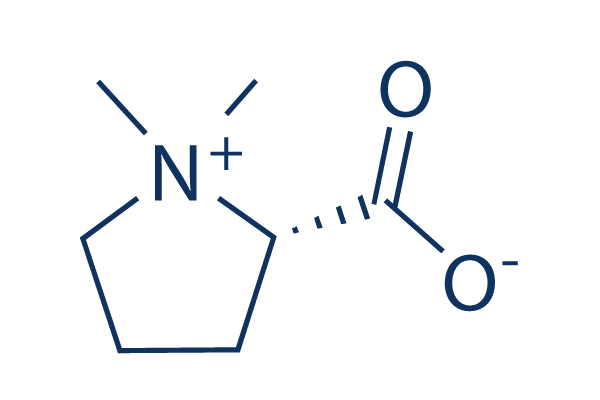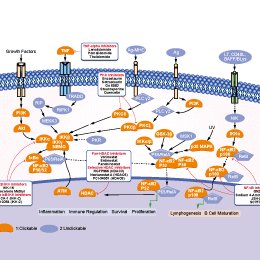
- Bioactive Compounds
- By Signaling Pathways
- PI3K/Akt/mTOR
- Epigenetics
- Methylation
- Immunology & Inflammation
- Protein Tyrosine Kinase
- Angiogenesis
- Apoptosis
- Autophagy
- ER stress & UPR
- JAK/STAT
- MAPK
- Cytoskeletal Signaling
- Cell Cycle
- TGF-beta/Smad
- DNA Damage/DNA Repair
- Compound Libraries
- Popular Compound Libraries
- Customize Library
- Clinical and FDA-approved Related
- Bioactive Compound Libraries
- Inhibitor Related
- Natural Product Related
- Metabolism Related
- Cell Death Related
- By Signaling Pathway
- By Disease
- Anti-infection and Antiviral Related
- Neuronal and Immunology Related
- Fragment and Covalent Related
- FDA-approved Drug Library
- FDA-approved & Passed Phase I Drug Library
- Preclinical/Clinical Compound Library
- Bioactive Compound Library-I
- Bioactive Compound Library-Ⅱ
- Kinase Inhibitor Library
- Express-Pick Library
- Natural Product Library
- Human Endogenous Metabolite Compound Library
- Alkaloid Compound LibraryNew
- Angiogenesis Related compound Library
- Anti-Aging Compound Library
- Anti-alzheimer Disease Compound Library
- Antibiotics compound Library
- Anti-cancer Compound Library
- Anti-cancer Compound Library-Ⅱ
- Anti-cancer Metabolism Compound Library
- Anti-Cardiovascular Disease Compound Library
- Anti-diabetic Compound Library
- Anti-infection Compound Library
- Antioxidant Compound Library
- Anti-parasitic Compound Library
- Antiviral Compound Library
- Apoptosis Compound Library
- Autophagy Compound Library
- Calcium Channel Blocker LibraryNew
- Cambridge Cancer Compound Library
- Carbohydrate Metabolism Compound LibraryNew
- Cell Cycle compound library
- CNS-Penetrant Compound Library
- Covalent Inhibitor Library
- Cytokine Inhibitor LibraryNew
- Cytoskeletal Signaling Pathway Compound Library
- DNA Damage/DNA Repair compound Library
- Drug-like Compound Library
- Endoplasmic Reticulum Stress Compound Library
- Epigenetics Compound Library
- Exosome Secretion Related Compound LibraryNew
- FDA-approved Anticancer Drug LibraryNew
- Ferroptosis Compound Library
- Flavonoid Compound Library
- Fragment Library
- Glutamine Metabolism Compound Library
- Glycolysis Compound Library
- GPCR Compound Library
- Gut Microbial Metabolite Library
- HIF-1 Signaling Pathway Compound Library
- Highly Selective Inhibitor Library
- Histone modification compound library
- HTS Library for Drug Discovery
- Human Hormone Related Compound LibraryNew
- Human Transcription Factor Compound LibraryNew
- Immunology/Inflammation Compound Library
- Inhibitor Library
- Ion Channel Ligand Library
- JAK/STAT compound library
- Lipid Metabolism Compound LibraryNew
- Macrocyclic Compound Library
- MAPK Inhibitor Library
- Medicine Food Homology Compound Library
- Metabolism Compound Library
- Methylation Compound Library
- Mouse Metabolite Compound LibraryNew
- Natural Organic Compound Library
- Neuronal Signaling Compound Library
- NF-κB Signaling Compound Library
- Nucleoside Analogue Library
- Obesity Compound Library
- Oxidative Stress Compound LibraryNew
- Plant Extract Library
- Phenotypic Screening Library
- PI3K/Akt Inhibitor Library
- Protease Inhibitor Library
- Protein-protein Interaction Inhibitor Library
- Pyroptosis Compound Library
- Small Molecule Immuno-Oncology Compound Library
- Mitochondria-Targeted Compound LibraryNew
- Stem Cell Differentiation Compound LibraryNew
- Stem Cell Signaling Compound Library
- Natural Phenol Compound LibraryNew
- Natural Terpenoid Compound LibraryNew
- TGF-beta/Smad compound library
- Traditional Chinese Medicine Library
- Tyrosine Kinase Inhibitor Library
- Ubiquitination Compound Library
-
Cherry Picking
You can personalize your library with chemicals from within Selleck's inventory. Build the right library for your research endeavors by choosing from compounds in all of our available libraries.
Please contact us at [email protected] to customize your library.
You could select:
- Antibodies
- Bioreagents
- qPCR
- 2x SYBR Green qPCR Master Mix
- 2x SYBR Green qPCR Master Mix(Low ROX)
- 2x SYBR Green qPCR Master Mix(High ROX)
- Protein Assay
- Protein A/G Magnetic Beads for IP
- Anti-Flag magnetic beads
- Anti-Flag Affinity Gel
- Anti-Myc magnetic beads
- Anti-HA magnetic beads
- Magnetic Separator
- Poly DYKDDDDK Tag Peptide lyophilized powder
- Protease Inhibitor Cocktail
- Protease Inhibitor Cocktail (EDTA-Free, 100X in DMSO)
- Phosphatase Inhibitor Cocktail (2 Tubes, 100X)
- Cell Biology
- Cell Counting Kit-8 (CCK-8)
- Animal Experiment
- Mouse Direct PCR Kit (For Genotyping)
- New Products
- Contact Us
Stachydrine
Synonyms: Proline betaine, L-stachydrine, Methyl hygrate betaine
Stachydrine (Proline betaine, L-stachydrine, Methyl hygrate betaine) is a quaternary ammonium derivative of proline that occurs widely in Medicago species. It is an osmoprotective compound found in urine. Stachydrine is a major constituent of Chinese herb leonurus heterophyllus sweet used to promote blood circulation and dispel blood stasis. Stachydrine can inhibit the NF-κB signal pathway.

Stachydrine Chemical Structure
CAS No. 471-87-4
Purity & Quality Control
Batch:
Purity:
98.86%
98.86
Stachydrine Related Products
Signaling Pathway
Biological Activity
| Description | Stachydrine (Proline betaine, L-stachydrine, Methyl hygrate betaine) is a quaternary ammonium derivative of proline that occurs widely in Medicago species. It is an osmoprotective compound found in urine. Stachydrine is a major constituent of Chinese herb leonurus heterophyllus sweet used to promote blood circulation and dispel blood stasis. Stachydrine can inhibit the NF-κB signal pathway. | |
|---|---|---|
| Targets |
|
| In vitro | ||||
| In vitro | Stachydrine inhibits cell proliferation and induces primary apoptosis and ROS production in T47D and MCF-7 cells in time- and dose-dependent manner. Its treatment induces caspase-3 activation and decreases the expression of the anti-apoptotic protein Bcl-2. Stachydrine simultaneously inhibits the phosphorylation of Akt and ERK proteins[1]. Stachydrine ameliorates the detrimental effect of high-glucose on EC (endothelial cells) and that its beneficial effect occurs through the modulation of cell senescence signaling and SIRT1 expression[2]. Stachydrine inhibits AngII-induced excessive autophagy within H9c2 cells. Stachydrine blocks the over phosphorylation of the p47phox subunit, decreases the translocation of p47phox and p67phox to the membrane, inhibits the activity of NOX2, and reduces the generation of ROS[3]. |
|||
|---|---|---|---|---|
| Cell Research | Cell lines | Endothelial cells | ||
| Concentrations | 0.1 mM | |||
| Incubation Time | 72 h | |||
| Method | The cell proliferation is determined by XTT after treatment with high-glucose (30 mM) in the presence or absence of stachydrine (0.1 mM) up to 72 h. Briefly, Endothelial cells (EC) are seeded in 96-well at a density of 4000 cells/well and incubated for 12, 24, 48, and 72h at 37 ºC with high-glucose alone or with high-glucose in the presence of stachydrine (0.1 mM). Control cells received normal glucose concentration or stachydrine (0.1 mM) alone. At the end of incubations, XTT assay is performed. The absorbance was measured at 492 nm in a spectrophotometer. |
|||
| In Vivo | ||
| In vivo | Stachydrine ameliorates transverse aortic constriction (TAC)-induced cardiac hypertrophy, dysfunction and excessive autophagy in vivo[3]. It shows significantly pharmacological properties including low toxicity, anti-inflammatory activities by improving the cellular membrane permeability, decreasing the levels of inflammatory factors and reducing the lipid peroxidation, and anti-oxidant activities by reducing plasma LDH activity and MDA levels, and protection against myocardial ischemia reperfusion injury in rats. The mean pharmacokinetic parameters of stachydrine after oral administration of Herba Leonuri extract: Tmax=0.75 h, t1/2z=1.64 h[4]. |
|
|---|---|---|
| Animal Research | Animal Models | Transverse aortic constriction animal model (Wistar rats) |
| Dosages | 8 mg/kg | |
| Administration | by oral gavage | |
| NCT Number | Recruitment | Conditions | Sponsor/Collaborators | Start Date | Phases |
|---|---|---|---|---|---|
| NCT05073523 | Completed | Healthy |
Chalmers University of Technology |
September 27 2021 | Not Applicable |
Chemical Information & Solubility
| Molecular Weight | 143.18 | Formula | C7H13NO2 |
| CAS No. | 471-87-4 | SDF | Download Stachydrine SDF |
| Smiles | C[N+]1(CCCC1C(=O)[O-])C | ||
| Storage (From the date of receipt) | |||
|
In vitro |
DMSO : 29 mg/mL ( (202.54 mM) Moisture-absorbing DMSO reduces solubility. Please use fresh DMSO.) Water : 29 mg/mL Ethanol : 15 mg/mL |
Molecular Weight Calculator |
|
In vivo Add solvents to the product individually and in order. |
In vivo Formulation Calculator |
||||
Preparing Stock Solutions
Molarity Calculator
In vivo Formulation Calculator (Clear solution)
Step 1: Enter information below (Recommended: An additional animal making an allowance for loss during the experiment)
mg/kg
g
μL
Step 2: Enter the in vivo formulation (This is only the calculator, not formulation. Please contact us first if there is no in vivo formulation at the solubility Section.)
% DMSO
%
% Tween 80
% ddH2O
%DMSO
%
Calculation results:
Working concentration: mg/ml;
Method for preparing DMSO master liquid: mg drug pre-dissolved in μL DMSO ( Master liquid concentration mg/mL, Please contact us first if the concentration exceeds the DMSO solubility of the batch of drug. )
Method for preparing in vivo formulation: Take μL DMSO master liquid, next addμL PEG300, mix and clarify, next addμL Tween 80, mix and clarify, next add μL ddH2O, mix and clarify.
Method for preparing in vivo formulation: Take μL DMSO master liquid, next add μL Corn oil, mix and clarify.
Note: 1. Please make sure the liquid is clear before adding the next solvent.
2. Be sure to add the solvent(s) in order. You must ensure that the solution obtained, in the previous addition, is a clear solution before proceeding to add the next solvent. Physical methods such
as vortex, ultrasound or hot water bath can be used to aid dissolving.
Tech Support
Answers to questions you may have can be found in the inhibitor handling instructions. Topics include how to prepare stock solutions, how to store inhibitors, and issues that need special attention for cell-based assays and animal experiments.
Tel: +1-832-582-8158 Ext:3
If you have any other enquiries, please leave a message.
* Indicates a Required Field
Tags: buy Stachydrine | Stachydrine supplier | purchase Stachydrine | Stachydrine cost | Stachydrine manufacturer | order Stachydrine | Stachydrine distributor







































